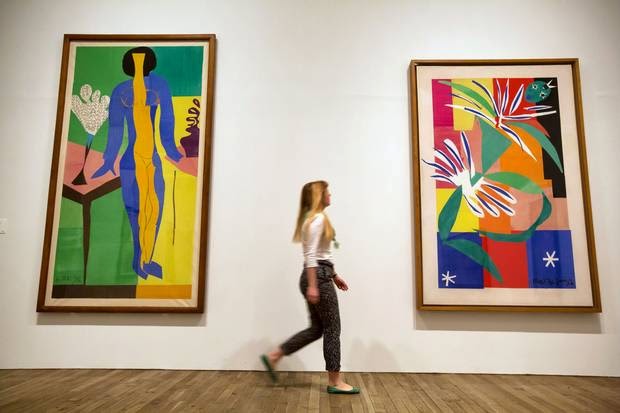You can see clearly in this cut-out picture why Matisse started to do them. It's covered with pins and nothing is glued. The papers are all odds and ends of shapes used to make outlines. This is so he could experiment with blocks of colour and get the right shapes for them - the most expressive shape, and also experiment with positioning the shapes. You might think he could get it right first time but he certainly didn't. This picture shows violence (black) wickedness (yellow) and a human (white). For a while he was interested in working with these symbolic colours but he did move on to use other colours.
He made a book called Jazz that was meant to illustrate poems, but the hand-written notes he make as he worked on the cut-outs were published as the text. These works are not the most gripping.
Oceania comes next - a wall of cut outs made from white paper. He pinned cut-out paper fish, coral and leaves to the wall of his Paris apartment.
 |
| Interesting way of showing jellyfish - straight lines in the composition |
 |
| Just one example from Matisse's wall of shapes |
The chapel at Vence - this is where the offspring and I began to be engrossed. Matisse was asked to design the decor of the whole chapel.
And apart from the glorious stained glass windows he designed chasubles! the designs were made from the cut out method.
 |
| The cut out is much bigger that this - life size and in the Tate show. |
 |
| The fact that these designs were actually made is not made clear in the Tate show. Wow. |
Other vestments designed by Matisse not in the Tate show:
Apparently Matisse did this for a religious friend who had nursed him through an illness. He became completely inspired by the project.
Matisse then began working on a larger scale.
The left hand picture, Zulma, shows depth in the composition. On the right, Creole dancer is based on the experience of having a dancer perform in the studio.
Personally, I love the largest compositions because of their exuberance and joy. I love the fact that an artist can communicate these feelings in his later years - his eighties.
And finally, we see all four blue nudes in one room - what a coup!
I found the show very inspiring and joyful. But husband didn't - he was very Brian Sewell about it. Here is Brian Sewell's view in the Evening Standard.
Enjoy the gaiety of colour. Be moved by the myth of the old genius, victim of a botched stomach operation, discovering new inspiration when told that death was on his doorstep. Be astonished by this sensualist turned saint, finding God in his own work, lying a-bed and drawing on the wall with a six-foot pole, cluttering every surface with the worst drawings this worst of draughtsmen ever did. Delight in the jaunty amusements of the infants’ school, but do not discard your critical faculties. Is what you see in this Matisse really a match for Michelangelo’s Adam, his nude youths, his prophets and sybils, his Last Judgement? What nonsense.
Enjoy these seductive trivialities for what they are — insubstantial, deceitful, fraudulent and, we must hope, transient, rather than some spiritual and mystical essence of art. Having no doubt that the number of visitors between now and September will break the record for Tate Modern (and so, perhaps, it should), I hope only that, unlike the early critics, they will cling to reason.the whole article is here for your delight.
Strange, isn't it? He thinks it can't be all that good because it's paper and scissors ("the jaunty amusements of the infants' school") and it can't be good because it's not Michelangelo and his lofty, educated themes. I do disagree so much. This is not art for the educated, or art that is linked with one religion and alienates adherents of other religions.
Husband felt that there was no craft or skill to it and I suppose he found the themes "trivial" too, but I disagreed so much that I felt offended.








No comments:
Post a Comment